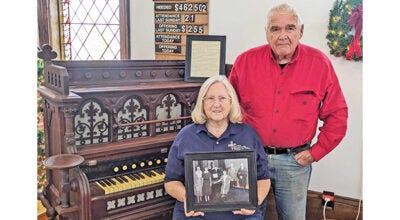Andrews University Museum offers unique collection
Published 5:29 pm Thursday, January 16, 2014
BERRIEN SPRINGS—If you thought you had to travel all the way to the Field Museum in Chicago, Ill. to see a real wooly mammoth, think again. In fact, the most complete skeleton of a mammoth to be found in Michigan is on display in Berrien Springs, Mich., at the Andrews University Museum of Natural History.
“It’s not a Field Museum, obviously,” said Dr. H. Thomas Goodwin, professor of paleobiology and chairman of the biology department at Andrews, “but we do have quite a nice collection of stuff.”
“Certainly, our most famous draw is the mammoth. We have what we call the ‘Prillwitz mammoth,’ which was found on the Wesley Prillwitz farm back in the early 1960s,” Goodwin said. “By direct line of flight, it would be two miles away from here, but it’s slightly further by car.”
“When Mr. Prillwitz was having a pond excavated, dredging it to make it deeper, he ran across this mammoth, and it is the most complete mammoth ever found in Michigan up to this point,” Goodwin said. “It’s a very nice specimen.”
While the museum has a nearly-complete skeleton of a mammoth on display, it also has the tusk of a mastodon which was discovered in southwest Michigan.
“We have the tusk of a mastodon, what we call ‘the Carmichael Mastodon,’” Goodwin said. “These tusks were excavated near Watervliet back in the 1970s.”
According to Dr. Goodwin, “Mastodons were more common here in Michigan than the mammoths, in a ratio of about four to one, probably because of the environment.”
Visitors can learn more about the differences between the two species of extinct mammals when they visit the museum, and they can also learn about animals that currently live in both Michigan and in other parts of the world.
“We have two areas of better coverage,” Goodwin said. “One would be local specimens, and we have quite a collection of both mammals and birds from Peru.”
“The museum, really, is kind of an old-fashioned museum with the stuffed specimens, but it also has a quite a nice teaching collection of specimens, especially mammals and birds,” Goodwin said. “We also have quite a few insects and a shell collection.”
“The shells were donated by an individual. They really don’t have significant scientific value, but they have a nice display value,” Goodwin said. “They’re cool. They have nice variation.”
“We have a crocodile skull. We have bears, just lots and lots of different things. And then, we have a series of casts, including an extinct lion that used to live here in the United States, a saber-toothed cat — the smilodon, and a giant beaver. We have a number of Ice Age casts,” Goodwin said. “We have various teeth of mammoths and mastodons. We have a number of hominid skull casts as well.”
“If a school group is doing something on diversity, and they want to do something locally, we have quite a nice collection of specimens,” Goodwin said.
“Typically, when groups come here to visit, they spend a half an hour or 45 minutes,” Goodwin said. “We also have a green house up on the top floor that has a tropical room and a desert room and so on, so sometimes when school groups come, some of them will want to do that — visit the museum and the greenhouse.”
Individuals and families with children are also welcome to visit the museum. Although it is not open on a regular basis, visits to the Andrews University Museum of Natural History can be arranged by calling Mayra Robertson in the Biology office at (269) 471-3243 during normal business hours. The museum is located in G. McCready Price Hall, 4280 Administration Dr., on the Andrews University campus.
“With a little bit of advanced notice, we’re happy to do that — to open it up and let people come take a look,” Goodwin said. “We have that happen on a fairly regular basis.”






